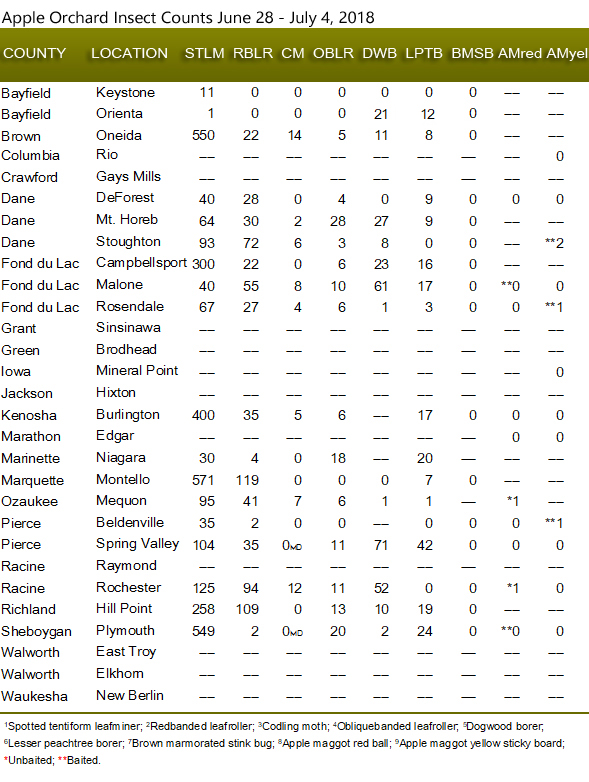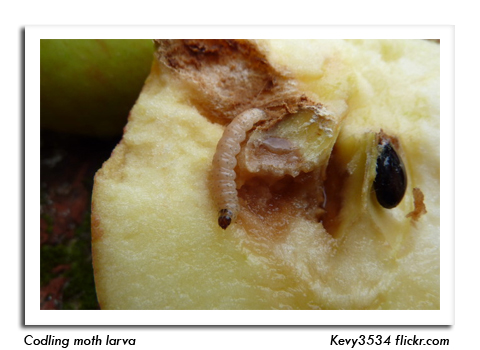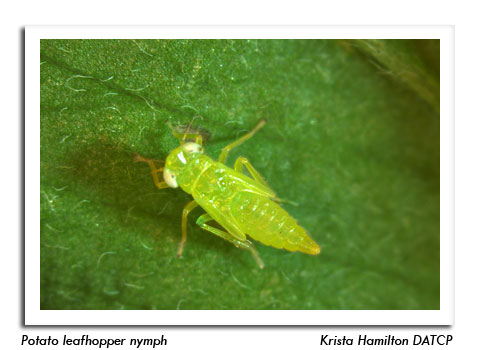
 |
|
|
Fruits
Volume 63 Number 10 Date 07/05/2018 APPLE MAGGOT - Emergence of adults began last week, with captures of 1-2 flies reported from cooperating orchards in Brown, Dane and Fond du Lac counties. Counts for the period of June 28-July 4 were similar at 1-2 flies per trap in four of 14 reporting orchards. Apple maggot traps should be cleaned of non-target flies periodically and recoated with insect sticky trap material as needed. CODLING MOTH - Counts have decreased in most orchards as the first flight subsides. Orchardists who have not observed a distinct decline in moth activity and are having difficulty determining the most effective treatment window should use an accumulation of 1,000 degree days (modified base 50°F) from the spring biofix in late May to time the start of larvicide applications. As a general rule, approximately 1,000 degree days are required between the first and second larval generations. POTATO LEAFHOPPER - Rising populations in alfalfa fields could translate into fruit tree damage as harvesting of second-crop hay increases. Non-bearing, one- to two-year-old trees are most susceptible to leafhopper feeding and should be monitored for upwards leaf cupping and yellowing of terminal shoots. Treatment is justified at levels of one or more nymphs per leaf when hopperburn symptoms are developing. SPOTTED TENTIFORM LEAFMINER - The second flight should peak soon at most monitoring sites. Egg laying is expected to be heavy as long as pheromone traps continue to register high numbers of moths. Apple orchards with populations greater than one mine per leaf or a history of infestation may consider treatment of second generation larvae to reduce build-up of leafminers before the third flight begins in August. GRAPE BERRY MOTH - Female moths will soon begin laying second-generation eggs in southern and western Wisconsin vineyards. Scouting for infested fruits and other signs of GBM, particularly in border rows adjacent to wooded areas in the vineyard, is advised. Treatment of perimeter rows, if warranted, usually provides satisfactory control of this pest. The use of pheromone traps to monitor GBM flights and properly time controls is also strongly recommended. OBLIQUEBANDED LEAFROLLER - Developing fruits should be inspected for larval hatch and feeding injury by the first generation of leafrollers. Larvae require either fruit or foliage, and have begun to feed on available fruits in south-central and southwestern orchards. Effective control of the first generation at this time will minimize injury and reduce the size of the later generation in August and September. Treatment is justifiable when 3% of terminals are infested (based upon examination of 5 growing points per tree in at least 10 widely separated trees). -- Krista Hamilton, DATCP Entomologist 




|
|
|